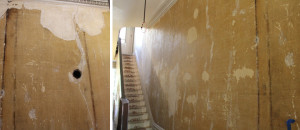Ongoing Restoration News: These Walls Can Still Talk
On Friday, September 16, 2011, in preparation for the next stage of our structural restoration project, sheets of 20th century architectural canvas were removed from the east wall in the parlor floor hallway — revealing the original plaster, complete with 19th-century paint. The cracks caused by water and the passage of time have now been repaired and a temporary paint coat applied.
The “Fab-rik-o-na” canvas was applied in 1935 by the Museum’s founder, George Chapman, to create a smooth surface over aging plaster — a common practice at that time. When the canvas layer (and its coats of 20th century paint) was peeled away, it revealed a 19th-century wall surface that hadn’t been seen in over 75 years. It also uncovered a wealth of clues that will provide information about how the House was decorated, how the hallway was used, and when the Tredwells (who lived here for nearly 100 years) made changes.

- A hole near the foyer shows where a pipe was attached for a free-standing coal stove. No doubt cold air swept in whenever the front door was opened. The stove was removed when the family installed an elevator in the same spot following daughter Sarah’s carriage accident in 1872.
- Dark lines on the wall show where the elevator shaft was built out into the hallway, corresponding exactly with evidence of the elevator discovered on the hallway floorboards in an earlier investigation.
- A plaster patch the size of a quarter near the ceiling indicates that a substantial picture hook was once attached in line with the ceiling medallion for the hallway light fixture. It’s likely that a mirror once hung there, to reflect the light and create the illusion of moore space.
- The 1870 paint color in the hallway is now visible. It has oxidized to an ocher and the glaze over it is also clearly visible. Further paint analysis will determine the original color, of course. It also matches the color that the house was painted in the early 1930s, when it became a museum.
- A fragment of 1840s/50s floor cloth was found under the plumbing chase on the wall.
The evidence provided by the newly revealed wall will go a long way towards unraveling some of the more persistent riddles about the House. Stay tuned.


